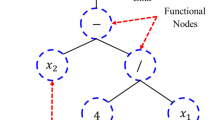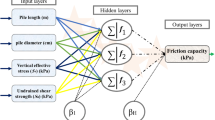Abstract
It is normal to do a pile load test to verify the pile capacity before construction using either a static load test or a high-strain dynamic test (HSDT). The latter is favourable due to its simplicity and lower cost, but it lacks a simple equation that could be used to interpret its results. This study aims to develop a simple model that could be easily utilized to estimate the pile capacity. The model has been developed using EPR-MOGA, a regression analysis aid with a genetic algorithm, utilizing database of HSDT of piles. The accuracy of the new model has been examined by calculating the mean absolute error, root mean square error, mean, coefficient of determination, and ratio of prediction with an error range of ± 20%. The model showed very good accuracy and thus, it could be used with confidence. The model has the potential to reduce costs and difficulties associated with the interpretation of the HSDT.









Similar content being viewed by others
Data Availability
The data utilized in this study can be obtained upon request.
Code Availability
The code implemented in this study can be provided upon request.
References
Abu-Farsakh, M.Y., Shoaib, M.M.: Machine learning models to evaluate the load-settlement behavior of piles from cone penetration test data. Geotech. Geol. Eng. (2024). https://doi.org/10.1007/s10706-023-02737-6
Al Adwan, J., Al Thawabteh, J., Alzubi, Y.: Developing ensemble machine learning for estimating and parametrically assessing the moment capacity of ferrocement members. Asian J Civ Eng (2024). https://doi.org/10.1007/s42107-024-01012-0
Al-Hamd, R.K.S., Albostami, A.S., Alzabeebee, S., Al-Bander, B.: An optimized prediction of FRP bars in concrete bond strength employing soft computing techniques. J. Build. Eng. p108883 (2024). https://doi.org/10.1016/j.jobe.2024.108883
Alzabeebee, S., Chapman, D.N.: Evolutionary computing to determine the skin friction capacity of piles embedded in clay and evaluation of the available analytical methods. Trans. Geotech. 24, 100372 (2020). https://doi.org/10.1016/j.trgeo.2020.100372
Alzabeebee, S., et al.: Development of a new explicit soft computing model to predict the blast-induced ground vibration. Geomech. Eng. 30(6), 551–564 (2022). https://doi.org/10.12989/gae.2022.30.6.551
Alzabeebee, S., Mohammed, D.A., Alshkane, Y.M.: Experimental study and soft computing modeling of the unconfined compressive strength of limestone rocks considering dry and saturation conditions. Rock Mech. Rock Eng. 55, 5535–5554 (2022). https://doi.org/10.1007/s00603-022-02948-y
Anitha Mary, X., Sharma, B., Johnson, I., Chalmers, J., Karthik, C., Chowdhury, S.: Performance analysis of groundwater quality index models for predicting water district in Tamil Nadu using regression techniques. Int. J. Comput. Mater. Sci. Eng. p 2350048 (2023). https://doi.org/10.1142/S2047684123500483
Armaghani, D.J., Harandizadeh, H., Momeni, E., Maizir, H., Zhou, J.: An optimized system of GMDH-ANFIS predictive model by ICA for estimating pile bearing capacity. Artif. Intell. Rev. 55, 2313–2350 (2022). https://doi.org/10.1007/s10462-021-10065-5
Benbouras, M.A., Petrişor, A.I., Zedira, H., Ghelani, L., Lefilef, L.: Forecasting the bearing capacity of the driven piles using advanced machine-learning techniques. Appl. Sci. 11(22), 10908 (2021). https://doi.org/10.3390/app112210908
Bhaskar, V.V., Srinivas, K., Devireddy, S.B.R.: A computational micromechanical approach to predicting Young’s modulus of continuous banana and palmyra fiber-reinforced epoxy composites. Int J Comput Mater Sci Eng 12(02), 2250023 (2023). https://doi.org/10.1142/S2047684122500233
Carvalho, S.L., Sales, M.M., Cavalcante, A.L.B.: Systematic literature review and mapping of the prediction of pile capacities. Soils Rocks 46, e2023011922 (2023). https://doi.org/10.28927/SR.2023.011922
Chen, W., Sarir, P., Bui, X.N., et al.: Neuro-genetic, neuro-imperialism and genetic programing models in predicting ultimate bearing capacity of pile. Eng. Comput. 36, 1101–1115 (2020). https://doi.org/10.1007/s00366-019-00752-x
Duan, M., Xiao, X.: Enhancing soil pile-bearing capacity prediction in geotechnical engineering using optimized decision tree fusion. Multiscale and Multidiscip. Model. Exp. Des. (2024). https://doi.org/10.1007/s41939-024-00375-w
Fattahi, H., Hasanipanah, M.: Prediction of blast-induced ground vibration in a mine using relevance vector regression optimized by metaheuristic algorithms. Nat. Resour. Res. 30, 1849–1863 (2021). https://doi.org/10.1007/s11053-020-09764-7
Giustolisi, O., Savic, D.A.: A symbolic data-driven technique based on evolutionary polynomial regression. J. Hydroinf. 8(3), 207–222 (2006)
Giustolisi, O., Savic, D.A.:Advances in data-driven analyses and modelling using EPR-MOGA. J. Hydroinf. 11(3-4), 225–236 (2009)
Gu, W., Liao, J., Cheng, S.: Bearing capacity prediction of the concrete pile using tunned ANFIS system. J. Eng. Appl. Sci. 71, 39 (2024). https://doi.org/10.1186/s44147-024-00369-y
Huat, C.Y., Moosavi, S.M.H., Mohammed, A.S., Armaghani, D.J., Ulrikh, D.V., Monjezi, M., Hin Lai, S.: Factors influencing pile friction bearing capacity: Proposing a novel procedure based on gradient boosted tree technique. Sustainability 13(21), 11862 (2021). https://doi.org/10.3390/su132111862
Keawsawasvong, S., Sangjinda, K., Jitchaijaroen, W., et al.: Soft Computing-Based Models for Estimating the Ultimate Bearing Capacity of an Annular Footing on Hoek-Brown Material. Arab. J. Sci. Eng. (2023). https://doi.org/10.1007/s13369-023-08588-w
Kumar, D.R., Wipulanusat, W., Kumar, M., Keawsawasvong, S., Samui, P.: Optimized neural network-based state-of-the-art soft computing models for the bearing capacity of strip footings subjected to inclined loading. Intell. Syst. Appl. 21, 200314 (2024). https://doi.org/10.1016/j.iswa.2023.200314
Liu, T.: Driven piles’ load capacity estimation by applying comparative regression methods. Multiscale and Multidiscip. Model. Exp. and Des. 7, 31–42 (2024). https://doi.org/10.1007/s41939-023-00184-7
Luo, Z., Hasanipanah, M., Bakhshandeh Amnieh, H., Brindhadevi, K., Tahir, M.M.: GA-SVR: a novel hybrid data-driven model to simulate vertical load capacity of driven piles. Eng. Comput. 37, 823–831 (2021). https://doi.org/10.1007/s00366-019-00858-2
Moayedi, H., Varamini, N., Mosallanezhad, M., Foong, L.K., Le, B.N.: Applicability and comparison of four nature-inspired hybrid techniques in predicting driven piles’ friction capacity. Trans. Geotech. 37, 100875 (2022). https://doi.org/10.1016/j.trgeo.2022.100875
Mohanty, R., Suman, S., Das, S.K.: Prediction of vertical pile capacity of driven pile in cohesionless soil using artificial intelligence techniques. Int. J. Geotech. Eng. 12(2), 209–216 (2018). https://doi.org/10.1080/19386362.2016.1269043
Momeni, E., Nazir, R., Armaghani, D.J., Maizir, H.: Prediction of pile bearing capacity using a hybrid genetic algorithm-based ANN. Measurement 57, 122–131 (2014)
Nath, K.: The role of artificial intelligence in the modeling, analysis and inspection of ultrasonic welding processes—A review. Int. J. Comput. Mater. Sci. Eng. 12(02), 2230001 (2023). https://doi.org/10.1142/S2047684122300010
Nguyen, S.M., Tran, N.L., Nguyen, T.H., et al.: Efficient neural network- and tree-based machine learning models for predicting shear capacity of RC slender walls. Asian J Civ Eng (2024). https://doi.org/10.1007/s42107-024-00998-x
Pham, T.A., Tran, V.Q.: Developing random forest hybridization models for estimating the axial bearing capacity of pile. Plos One 17(3), e0265747 (2022). https://doi.org/10.1371/journal.pone.0265747
Phoon, K.K., Zhang, W.: Future of machine learning in geotechnics. Georisk 17(1), 7–22 (2023). https://doi.org/10.1080/17499518.2022.2087884
Rabbani, A., Muslih, J.A., Saxena, M. et al.: Utilization of tree-based ensemble models for predicting the shear strength of soil. Transp. Infrastruct. Geotech. (2024). https://doi.org/10.1007/s40515-024-00379-6
Ray, R., Kumar, D., Samui, P., Roy, L.B., Goh, A.T.C., Zhang, W.: Application of soft computing techniques for shallow foundation reliability in geotechnical engineering. Geosci. Front. 12(1), 375–383 (2021). https://doi.org/10.1016/j.gsf.2020.05.003
Sangjinda, K., Banyong, R., Alzabeebee, S., Keawsawasvong, S.: Developing soft-computing regression model for predicting bearing capacity of eccentrically loaded footings on anisotropic clay. Artif. Intell. Geosci. 4, 68–75 (2023a). https://doi.org/10.1016/j.aiig.2023.05.001
Sangjinda, K., Banyong, R., Alzabeebee, S., Keawsawasvong, S.: Developing soft-computing regression model for predicting bearing capacity of eccentrically loaded footings on anisotropic clay. Artif. Intell. Geosci. 4, 68–75 (2023b). https://doi.org/10.1016/j.aiig.2023.05.001
Soni, S., Chauhan, M., Singh, P. et al.: Optimizing construction time, cost, and quality: a hybrid AHP-NSGA-II optimization model. Asian J. Civ. Eng. (2024). https://doi.org/10.1007/s42107-024-01030-y
Sun, W., Zhang, W., Han, L.: Determination of groundwater buoyancy reduction coefficient in clay: Model tests, numerical simulations and machine learning methods. Under. Space 13, 228–240 (2023). https://doi.org/10.1016/j.undsp.2023.06.001
Tran, D.T., Onjaipurn, T., Kumar, D.R., et al.: An eXtreme Gradient Boosting prediction of uplift capacity factors for 3D rectangular anchors in natural clays. Earth Sci Inform (2024). https://doi.org/10.1007/s12145-024-01269-8
Wang, C., Liu, H., Ding, X., Wang, C., Ou, Q.: Study on horizontal bearing characteristics of pile foundations in coral sand. Can. Geotech. J. 99(999), 1928–1942 (2021). https://doi.org/10.1139/cgj-2020-0623
Yang, X.: Prediction of pile-bearing capacity using Least Square Support Vector Regression: individual and hybrid models development. Multiscale and Multidiscip. Model. Exp. and Des. (2024). https://doi.org/10.1007/s41939-023-00357-4
Yong, W., Zhou, J., Jahed Armaghani, D., et al.: A new hybrid simulated annealing-based genetic programming technique to predict the ultimate bearing capacity of piles. Eng. Comput. 37, 2111–2127 (2021). https://doi.org/10.1007/s00366-019-00932-9
Yunpeng, L., Shenghuan, D., Yingbin, J. et al.: Estimation of pile-bearing capacity applying hybrid auto-regressed models based on regression decision tree. Multiscale and Multidiscip. Model. Exp. and Des. (2023). https://doi.org/10.1007/s41939-023-00330-1
Zhang, W., Li, H., Li, Y., et al.: Application of deep learning algorithms in geotechnical engineering: a short critical review. Artif. Intell. Rev. 54, 5633–5673 (2021a). https://doi.org/10.1007/s10462-021-09967-1
Zhang, W., Wu, C., Zhong, H., Li, Y., Wang, L.: Prediction of undrained shear strength using extreme gradient boosting and random forest based on Bayesian optimization. Geosci. Front. 12(1), 469–477 (2021b). https://doi.org/10.1016/j.gsf.2020.03.007
Acknowledgements
The authors thank the Al-Maarif University College for the finical support of this work.
Funding
This study was funded by Al-Maarif University |College Under Grant No. 4545.
Author information
Authors and Affiliations
Corresponding author
Ethics declarations
Ethical Approval
The authors state that the research was conducted according to ethical standards.
Informed Consent
For the type of this study, formal consent is not required.
Conflicts of Interest
The authors have no conflict of interest related to this submission, and they have no relevant financial or non-financial interests to disclose.
Additional information
Publisher's Note
Springer Nature remains neutral with regard to jurisdictional claims in published maps and institutional affiliations.
Rights and permissions
Springer Nature or its licensor (e.g. a society or other partner) holds exclusive rights to this article under a publishing agreement with the author(s) or other rightsholder(s); author self-archiving of the accepted manuscript version of this article is solely governed by the terms of such publishing agreement and applicable law.
About this article
Cite this article
Alzabeebee, S., Ismael, B.H., Keawsawasvong, S. et al. An Evolutionary Polynomial Computing of Pile Capacity Using the Results of High-strain Dynamic Test. Transp. Infrastruct. Geotech. (2024). https://doi.org/10.1007/s40515-024-00411-9
Accepted:
Published:
DOI: https://doi.org/10.1007/s40515-024-00411-9




